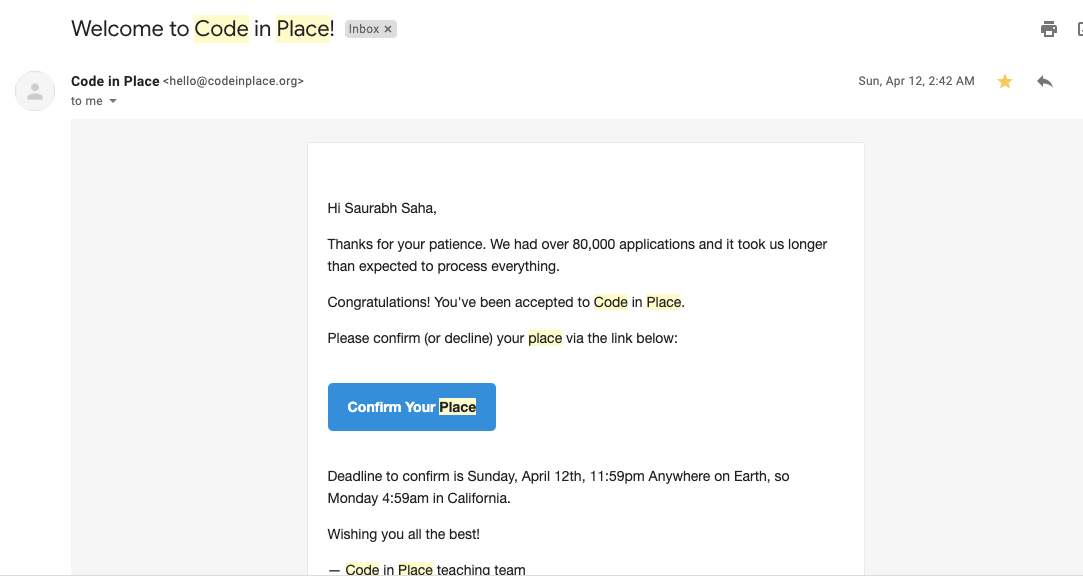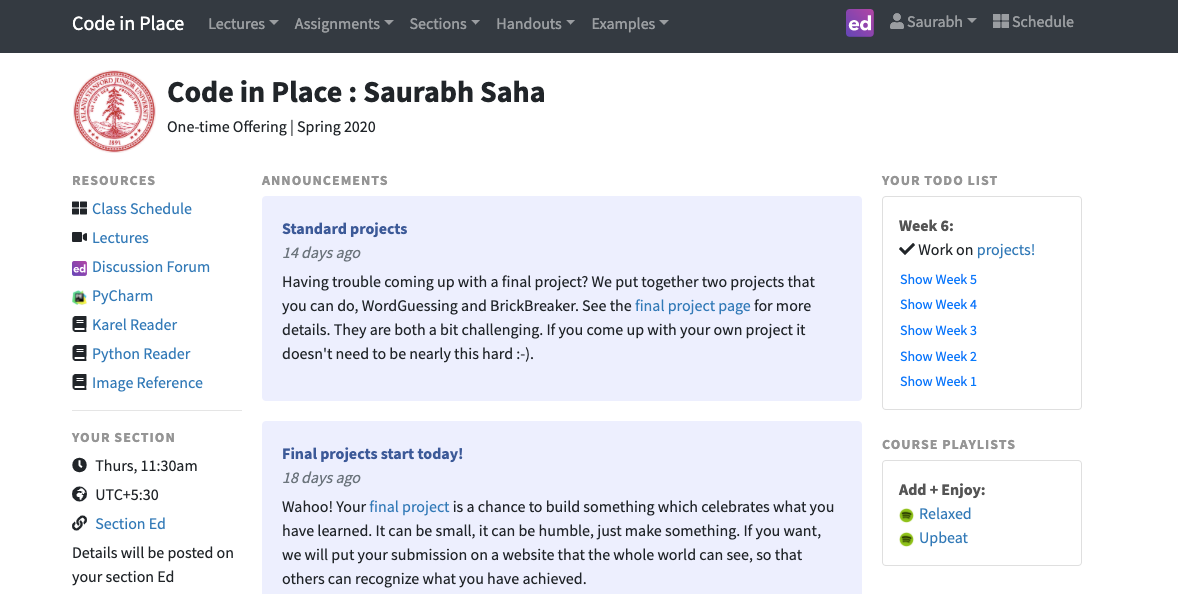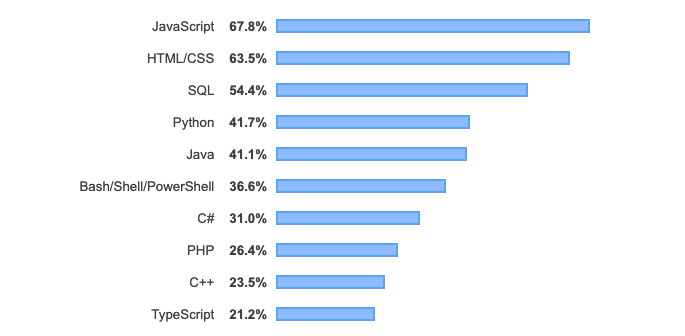Stanford Code In Place
It's been way too long since I wrote the last blog. I must say the Corona bug got the better of my intellectual side. Human nature has been baffling people for over 2 milleniums and I am no different. I resolved to write everyday after I learnt Jerry Seinfield wrote everyday in his life much before be became a billionaire. So I decided to unleash my writing prowess once again on the innocuous diaspora unaware of my evil intentions. But the biggest problem was to decide what to write on. I mean with COVID19 eating half the world with one of the largest pandemics human history has ever seen and economists around the world gossiping over evening snacks on a potential economic depression which seems far more disastrous than the great depression of the 1960s.Nothing seemed anything close to remotely pleasant. It seems the entire world had gone berserk. Conspiracy theorists were weaving their own stores about COVID19 being a bioterrorism attack. Amidst all this,India witnessed the biggest lockdown in 72 years. Something I had never seen over the last 4 decades of my mortal lifetime. Although it didn't bring any change to socially introvert nerds like me who are used to perennial loneliness, it did give me a lot of time to think about a lot of things, something Edward De Bono feels the human civilization hasn't done for over 200 years. But before I digress and bore you with my pandora's box of stories, let me tell you how I felt when I first saw the Code In Place ad in a leading website.

It was such a respite to read something other than the mayhem I was witnessing over the last one month or so. It's been 7 years since I last wrote code for one of my startups. I had near about forgotten all about Python programming. This seemed like a chance to go back to the drawing board and start learning again. It seemed difficult initially since the course demanded 15 hours per week and I had cooking, washing and cleaning to do along with several other commitments. But then what the heck!! I decided to go for it and I am glad I did. I filled up the form and answered the questions asked, uploaded my CV and solved three problems which was the best part of the selection process. After completing the application form and submitting, I felt so much joy. It felt like watching Obama roasting 'The Donald' in the White House Correspondent's Dinner'. But I didn't know what my fate was going to be. Would I get in or would I stare from the fences. The suspense was killing me. I even shot an email to Code In Place Team to find out about the results. Then as I was retiring for the day, my mobile buzzed and I saw this email in my inbox

I had gotten in. I wish I could tell anyone how happy I was. I received an invite to be part of the online community Ed too, since we would be communicating basically through Ed. The sessions started soon enough. We realised this is perhaps the largest remote education project in the history of mankind ,ever to be done at this scale which involved picking 1800 plus students from an applicant pool of 80000 plus with 800 section leaders from across the globe working with Stanford Professors Mehran Sahami along with Chris Piech. We also had a host of section leaders who were assigned a set of students chosen randomly. The section leaders were responsible for helping the students with the lessons being taught.
I was made part of Section 210 with a host of other fellow mates from across the world. We were all from different backgrounds. Our Section leader was Baris Bozkurt , a Computer Science professor from Turkey. He would perhaps be the most patient person I've seen in my entire life. The sessions were lit. This is what our section 210 looked like

Baris would explain us concepts that Mehran or Chris would have taught a particular week and would help us understand how the program would work. It actually took me back to my early programming career, where I was paired with an engineering manager who would teach me everything and ask me to code. So some of the things in these sessions became extremely clear. To top it all we'd all have assignments where we were supposed to use these concepts and solve a problem. Karel was the best part of these assignments. I am in love with Karel and still struggling with the midpoint problem. But Karel is a small robot built by Richard.E.Pattis.It is a robot programming language that is used to help students build logic. The best and perhaps the worst thing about Karel is that it can do just 4 things- move(), turn_left(), pick_beeper() and put_beeper(). So if you were Karel and you had to do a set of tasks , how would you do it provided you could do just 4 functions. It helps you think differently. This is exactly what algorithmic thinking is all about. I had so much fun doing Karel problems that I ended up completing all the problems in Karel except the midpoint problem but I am sure I'll crack it and hope ain't a bad thing as 'The Shawshank Redemption' taught us. But this is what Karel looks like- not sure if he can smile or not :)

This became my life over the next 6 weeks. Every single moment was exciting as I was solving problems, making mistakes, fixing them and in the process learning a lot from everyone around me. This compedu platform captivated my attention every now and then, since new lectures were uploaded on Mondays or Fridays.

I'd anxiously wait for Brahm Capoor and Ali Malik(two of our popular instructors), to inform us about the uploaded lectures and then we'd leave no stone unturned in gobbling them. I was having a gala time as a programmer after the operation heavy senior leadership roles I have taken up in the recent past. This was a period of creativity. This was learning that one could apply to build things out of nowhere. I didn't waste a minute in making maximum use of this time to write as much code as I could. You could find some of that on my github handle
We learnt anything and everything about the fundamental building blocks of python ranging from Control Flow, Variables, Decomposition,Variables, Expressions, Functions, Images, Graphics, Animation,Lists, Text Processing and Dictionaries. Most of the assignments made use of these concepts and so we'd get to use them in real time. It became a lot more clear how some of these concepts are wrapped around solving real world problems. As one would know Python is the 4th most popular language used by developers as per a stack overflow survey of Developers.

Emerging technologies like Machine Learning and Data Science tend to use a lot of python because its a complete OO language and type declaration isn't required like a statically linked language like C++/Java. Moreso the code is easy to write and reusable and one can build strong powerful applications out of it. Some of the top tech companies have actually used Python as part of their tech stack. I also had a fascination with Python since I had written the code for my first 2 startups in python and found it extremey easy to use, since I coded mostly in C++ and Java in an earlier life.
What was enjoyable was the fact that we were all helping each other solve problems without spoonfeeding it to each other. We wanted everyone to succeed by solving the problem themselves. Before I forget to mention, let me also say that Mehran and Chris added so much humour to the lectures that they'd become more entertaining and learning was anyway happening. The hero of the show, however was Chris's dog Simbaa who kept making cameo appearances. This isn't an episode of Doctor Who but an image problem called Warhole Problem after the famous artist Andy Warhole who was a cult figure in the Pop art movement, given to us and the poor thing found itself coloured in six different shades.

Toward the end we all submitted our respective final projects in the form of a youtube video that described what we had done. I ended up building a random number generator that took an image and converted it into a random number series and them produced a graph that showed the random number distribution. It was insane but it was fun.
I had the best time of my life and even when Code In Place has concluded, most of us are connected to each other via social media platforms and some slack groups. We are trying to collectively learn concepts around machine learning, data science, probability, statistics, multivariate calculus etc. It's perhaps the singular best thing that happened in 2020 ever since hell broke loose. I had decided earlier this year that I'd present something in PyCon 2020 and if that happens this year in October, I do have a lot to show. The Code In Place was the right thing to happen to me at an opportune moment when the entire world was drenched in chaos and there was nothing else to do other than being at home in a lockdown.
Before I go back to watching 'Billions' where Damien Lewis is about to gut Paul Giamatti, let me take a second to congratulate Stanford University on successfully wrapping up this gigantic project at an unimaginable scale. Stanford actually created history here and I would urge them to consider having most of the important classes open to people based on a selection process like they did with CS106A. They could actually change the way education has happened all this while over the last 500 years.



